Topic: Biological uses of silk: from webs to ballooning
What material is so versatile that it can be used for capturing prey, building nests, communication and even cleaning? The answer: that most remarkable of biomaterials - silk.
 Silk is familiar to us as a luxurious fabric, but its original producers, the arthropods, employ it for numerous (and very different) purposes. The characteristics of this fibrous protein make it one of the most remarkable of biomaterials (and it is also an excellent example of molecular convergence). Silk is secreted from glands as a liquid and then forms a thread that is in part crystalline. The mechanical properties of different types of silk differ significantly (some approaching the tensile strength of steel at a fraction of the weight), and this mainly depends on the amino acid composition. It is due to this versatility that silk plays a role in behaviours as diverse as foraging and courtship
Silk is familiar to us as a luxurious fabric, but its original producers, the arthropods, employ it for numerous (and very different) purposes. The characteristics of this fibrous protein make it one of the most remarkable of biomaterials (and it is also an excellent example of molecular convergence). Silk is secreted from glands as a liquid and then forms a thread that is in part crystalline. The mechanical properties of different types of silk differ significantly (some approaching the tensile strength of steel at a fraction of the weight), and this mainly depends on the amino acid composition. It is due to this versatility that silk plays a role in behaviours as diverse as foraging and courtship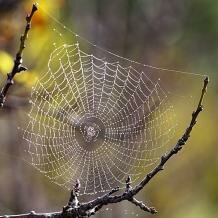 and has been crucial for the success of the groups that produce it.
and has been crucial for the success of the groups that produce it.
The masters of silk production are, of course, the spiders (Araneae). They spin silk throughout their lives from specific glands that are typically located on the posterior part of the body (opisthosoma). Spiders can secrete a variety of silk proteins, each with specific properties, from up to nine different types of gland. Silk production has, however, evolved independently in two other arachnid groups, the aptly named spider mites (Tetranychidae) and the pseudoscorpions (Pseudoscorpionida), and probably at least 23 times in the insects (e.g. in hymenopterans, caddisflies and butterflies), which typically secrete silk only during a specific phase in life. Recently, it has been discovered that a marine crustacean, the amphipod Crassicorophium bonellii, is also a silk producer.
Food capture
Silk is commonly used as a hunting aid. The most famous example is probably the spider web, but there are other ways…
Webs
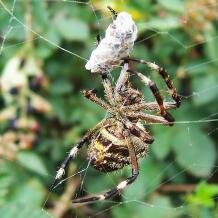 Many spiders construct webs of sticky silk to capture insect prey. There are several different types of web, including the well-known spiral orb webs built by spiders in several families (e.g. Araneidae). Some orb weavers (e.g. Octonoba sybotides) add conspicuous silk decorations to their webs, which reflect UV light and might actually attract prey to the web. Once caught, the insect struggles to break free, creating vibrations that alert the spider to its presence. The struggling victim may then be further immobilised by wrapping it in fine silk and eaten later.
Many spiders construct webs of sticky silk to capture insect prey. There are several different types of web, including the well-known spiral orb webs built by spiders in several families (e.g. Araneidae). Some orb weavers (e.g. Octonoba sybotides) add conspicuous silk decorations to their webs, which reflect UV light and might actually attract prey to the web. Once caught, the insect struggles to break free, creating vibrations that alert the spider to its presence. The struggling victim may then be further immobilised by wrapping it in fine silk and eaten later.  Other web types include funnel webs (e.g. in the family Agelenidae) or tube webs, as constructed by the aptly named tube-dwelling spiders (Segestriidae). These spiders tend to lay out silken alarm lines that signal the arrival of a potential victim. The rather unusual net-casting spiders (Deinopidae) make small webs that are suspended between their front legs and hurled onto approaching prey.
Other web types include funnel webs (e.g. in the family Agelenidae) or tube webs, as constructed by the aptly named tube-dwelling spiders (Segestriidae). These spiders tend to lay out silken alarm lines that signal the arrival of a potential victim. The rather unusual net-casting spiders (Deinopidae) make small webs that are suspended between their front legs and hurled onto approaching prey.
However, spiders are not the only arthropods that use webs for prey capture. In an aquatic environment, the same strategy is employed by many larval caddisflies (Trichoptera) and chironomids. Caddisfly species in the suborder Annulipalpia secrete large amounts of silk from labial glands to construct nets that are anchored to the substrate and collect food particles suspended in the water. Trichopteran silk has a comparatively low tensile strength, but by being highly extensible this might improve the performance of the capture net in fast-flowing streams (or reflect a constraint of producing silk underwater). Also related to the aqueous environment could be certain differences in the amino acid composition of trichopteran silk when compared to the silk produced by members of the sister order, the Lepidoptera. Many filter-feeding chironomid larvae also live in a silken tube with a conically shaped catchnet stretching across its lumen. The larvae may periodically eat the net and the food particles adhering to it, constructing a new net afterwards.
Other methods
 Not all spiders build webs to capture food – some have come up with rather more unusual methods. The aptly named spitting spiders (Scytodidae) subdue insects by spitting a mixture of silk, glue and venom onto them. This mixture is rapidly ejected in a highly controlled fashion through a very small opening at the tip of the fang, a process that requires a suite of morphological specialisations. Bolas spiders (e.g. Mastophora) produce a silken line that ends in a sticky blob, which they swing at moths flying past. This would probably be only moderately successful, were it not for a remarkable trick that the spiders employ to lure their prey within striking distance – they mimic the sex pheromones that the moths use in mate attraction. Intriguingly, some bolas spiders (e.g. M. hutchinsoni) are able to attract different moth species, despite sex pheromones being specific to a particular species.
Not all spiders build webs to capture food – some have come up with rather more unusual methods. The aptly named spitting spiders (Scytodidae) subdue insects by spitting a mixture of silk, glue and venom onto them. This mixture is rapidly ejected in a highly controlled fashion through a very small opening at the tip of the fang, a process that requires a suite of morphological specialisations. Bolas spiders (e.g. Mastophora) produce a silken line that ends in a sticky blob, which they swing at moths flying past. This would probably be only moderately successful, were it not for a remarkable trick that the spiders employ to lure their prey within striking distance – they mimic the sex pheromones that the moths use in mate attraction. Intriguingly, some bolas spiders (e.g. M. hutchinsoni) are able to attract different moth species, despite sex pheromones being specific to a particular species.
 A somewhat similar strategy is employed by some insects. The larvae of fungus gnats (Diptera) intercept small flies with sticky silk lines, which either hang from a web, resembling flypaper traps (e.g. in Arachnocampa luminosa), or are located in the ground (e.g. in Orfelia fultoni). To attract prey to these traps, the fungus gnats use a bioluminescent lure, emitting blue light from organs located in the head and tail (O. fultoni) or in the abdomen (A. luminosa).
A somewhat similar strategy is employed by some insects. The larvae of fungus gnats (Diptera) intercept small flies with sticky silk lines, which either hang from a web, resembling flypaper traps (e.g. in Arachnocampa luminosa), or are located in the ground (e.g. in Orfelia fultoni). To attract prey to these traps, the fungus gnats use a bioluminescent lure, emitting blue light from organs located in the head and tail (O. fultoni) or in the abdomen (A. luminosa).
Even more intriguing is the spider-like feeding method of a Hawaiian lepidopteran. The carnivorous caterpillar of the aptly named Hyposmocoma molluscivora feeds on snails. This is remarkable enough in itself, considering that most lepidopterans are herbivores, but this caterpillar spins a silken web that imprisons a resting snail and allows the predator to feed on the now immobilised prey. There are similar reports of predatory caterpillars from other Hawaiian islands.
Shelter and nest construction
Numerous arthropods employ silk in a rather more peaceful way, using it to construct nests or protective shelters. In some cases, the nests are made almost exclusively from silk, while in others silk is used as a binding or stitching material.
Silk as the main building material
Silk plays a major role in the lives of webspinners (Embiodea). These primitive insects construct elaborate silken galleries, in which they dwell, feed and lay eggs. These galleries, which can become so large that they cover entire tree trunks, consist of diurnal retreats (domiciles) and nocturnal foraging zones that are connected by tunnels.  Gathered materials and faeces can be incorporated into the silk structures, possibly for camouflage (e.g. in Oligotoma saundersii). Females often share a nest with their offspring and other females. In the species Anisembia texana, however, resident females seem to secrete a defensive silk with properties different from those of the silk covering to prevent other individuals from entering their domiciles. Life in the silken galleries is strikingly reflected in webspinner morphology. The wingless females have a highly flexible, streamlined body well suited for walking through the narrow tunnels. In the short-lived males, wings can be present, but these also possess a remarkable flexibility, allowing the insects even to move backwards through the tunnels. Furthermore, webspinners produce silk throughout their lives, from numerous silk glands (up to 230 per tarsus in Antipaluria urichi) on their greatly enlarged forelimb protarsomeres. Such unusual tarsal silk production has independently arisen in dance flies and tarantulas. A molecular characterisation of the silk of A. urichi revealed strikingly convergent similarities (e.g. in the amino acid composition), but also differences (e.g. a lower tensile strength) compared with other arthropod silks.
Gathered materials and faeces can be incorporated into the silk structures, possibly for camouflage (e.g. in Oligotoma saundersii). Females often share a nest with their offspring and other females. In the species Anisembia texana, however, resident females seem to secrete a defensive silk with properties different from those of the silk covering to prevent other individuals from entering their domiciles. Life in the silken galleries is strikingly reflected in webspinner morphology. The wingless females have a highly flexible, streamlined body well suited for walking through the narrow tunnels. In the short-lived males, wings can be present, but these also possess a remarkable flexibility, allowing the insects even to move backwards through the tunnels. Furthermore, webspinners produce silk throughout their lives, from numerous silk glands (up to 230 per tarsus in Antipaluria urichi) on their greatly enlarged forelimb protarsomeres. Such unusual tarsal silk production has independently arisen in dance flies and tarantulas. A molecular characterisation of the silk of A. urichi revealed strikingly convergent similarities (e.g. in the amino acid composition), but also differences (e.g. a lower tensile strength) compared with other arthropod silks.
The Australian leafhopper Kahaono montana also lives gregariously in silk structures, which are found on the underside of leaves. Until recently, it was assumed that these insects merely use silk produced by other arthropods (similar to the planthopper Myndus chazeauxi, which exploits silk structures made by spiders), but it has now been shown that they do indeed produce the silk themselves, making this the first evidence of silk production in a hemipteran. The selective pressures favouring silk production in this species are not fully understood, but the silk structures seem to provide protection from predators, especially lacewings.
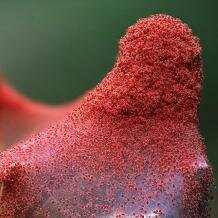 Amongst the arachnids, spider mites, well-known agricultural pests that infest a wide range of crops, produce similar three-dimensional silk webs. Interestingly, spider mite silk bears structural resemblance to the fibrous protein keratin, the main component of human skin, hair and nails. The ubiquitous red spider mite (Tetranychus urticae) deposits silk continuously while walking on a substrate. This silk protects the mite colony from predators, wind and rain, while also serving other functions. On the downside, the silk trails have been shown to attract predatory mites (e.g. Neoseiulus womersleyi), which follow them, probably by responding to chemical trail attributes rather than the physical trail itself. Pseudoscorpions too construct silk nests for moulting, reproduction and hibernation. The silk, which is secreted from cheliceral glands, also has a keratin-like structure.
Amongst the arachnids, spider mites, well-known agricultural pests that infest a wide range of crops, produce similar three-dimensional silk webs. Interestingly, spider mite silk bears structural resemblance to the fibrous protein keratin, the main component of human skin, hair and nails. The ubiquitous red spider mite (Tetranychus urticae) deposits silk continuously while walking on a substrate. This silk protects the mite colony from predators, wind and rain, while also serving other functions. On the downside, the silk trails have been shown to attract predatory mites (e.g. Neoseiulus womersleyi), which follow them, probably by responding to chemical trail attributes rather than the physical trail itself. Pseudoscorpions too construct silk nests for moulting, reproduction and hibernation. The silk, which is secreted from cheliceral glands, also has a keratin-like structure.
Silk as a binding material
Many examples of insects using silk to bind together plant parts are found in the Lepidoptera. 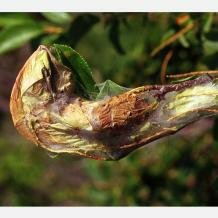 The caterpillars of the parsnip webworm (Depressaria pastinacella) weave the developing umbels of their host plants into a silken web, in which they feed on the suitable plant parts. They spend about a third of their time spinning silk, rendering web construction very costly, but the webs seem to divide up the available food resources amongst conspecifics, thus reducing aggressive interactions. Other caterpillars roll up leaves and use silk threads to hold them together, thus building a shelter in which to rest and feed, protected from predators and the elements. Larvae of the serpentine webworm moth (Herpetogramma aeglealis), for example, construct shelters on fern leaves. These caterpillars do not stay in one shelter but make several different ones throughout their larval life, which increase in size and complexity. The caterpillar of the cherry leaf roller (Caloptilia serotinella) manipulates the silk in such a way that it can generate considerable forces, capable of rolling up even the toughest leaves. In the social caterpillar Archips cerasivoranus, small groups of individuals manage to bend terminal branches and incorporate them into their shelter.
The caterpillars of the parsnip webworm (Depressaria pastinacella) weave the developing umbels of their host plants into a silken web, in which they feed on the suitable plant parts. They spend about a third of their time spinning silk, rendering web construction very costly, but the webs seem to divide up the available food resources amongst conspecifics, thus reducing aggressive interactions. Other caterpillars roll up leaves and use silk threads to hold them together, thus building a shelter in which to rest and feed, protected from predators and the elements. Larvae of the serpentine webworm moth (Herpetogramma aeglealis), for example, construct shelters on fern leaves. These caterpillars do not stay in one shelter but make several different ones throughout their larval life, which increase in size and complexity. The caterpillar of the cherry leaf roller (Caloptilia serotinella) manipulates the silk in such a way that it can generate considerable forces, capable of rolling up even the toughest leaves. In the social caterpillar Archips cerasivoranus, small groups of individuals manage to bend terminal branches and incorporate them into their shelter.
 A similar nest building behaviour is observed in weaver ants (in the genera Oecophylla, Dendromyrmex, Camponotus and Polyrhachis). Workers cooperate to bend leaves and bind them together with silken threads, resulting in a strong, waterproof nest. As adult weaver ants are unable to secrete silk, they employ their larvae as “sewing tools”. An adult holds a silk-releasing larva in its mandibles, shuttling it backwards and forwards. In only one ant species, Melissotarsus emeryi, adult workers have been shown to produce silk themselves. Here, it is secreted from glands located on the ventral rim of the head capsule, which are very different from the colleterial glands (i.e. accessory reproductive glands) that other adult hymenopterans use.
A similar nest building behaviour is observed in weaver ants (in the genera Oecophylla, Dendromyrmex, Camponotus and Polyrhachis). Workers cooperate to bend leaves and bind them together with silken threads, resulting in a strong, waterproof nest. As adult weaver ants are unable to secrete silk, they employ their larvae as “sewing tools”. An adult holds a silk-releasing larva in its mandibles, shuttling it backwards and forwards. In only one ant species, Melissotarsus emeryi, adult workers have been shown to produce silk themselves. Here, it is secreted from glands located on the ventral rim of the head capsule, which are very different from the colleterial glands (i.e. accessory reproductive glands) that other adult hymenopterans use.  Melissotarsus emeryi builds its nest by tunnelling into living wood and using silk for sealing slits and closing exit holes. As in some webspinners, bark fragments can be integrated into the silk. The advantages of silk use in this ant are not fully understood, but it could limit damage to the host plant or deter predators or parasites.
Melissotarsus emeryi builds its nest by tunnelling into living wood and using silk for sealing slits and closing exit holes. As in some webspinners, bark fragments can be integrated into the silk. The advantages of silk use in this ant are not fully understood, but it could limit damage to the host plant or deter predators or parasites.
Some species of raspy cricket (Gryllacrididae), the only orthopterans confirmed to produce silk to date, also use silk to limit access to the tree hollows they inhabit. Silk is secreted in the labial glands, and the major silk protein of Apotrechus illawarra possesses features convergent on those of the major silkworm and spider silk proteins. Silk use is variable in raspy crickets, and some species use silk to stabilise their underground burrows (as in various herbivorous beetles and similar to some bees and wasps, which enhance the strength and stiffness of their waxy combs by incorporating silk), while others use silk to join leaves together. All these different kinds of shelter probably provide protection from predators, and individuals have been shown to chemically label their shelter and return to it repeatedly.
In a freshwater environment, caddisfly larvae (e.g. Limnephilus decipiens) also use silk as a stitching fibre, sewing plant fragments into portable cases. Other species (e.g. Hydropsyche angustipennis) build silken tubes that incorporate sand grains or plant material. Many other arthropods use silk as a “glue” to hold particles together, with the marine amphipod Crassicorophium bonellii being a particularly interesting example. This semi-sessile crustacean has only recently been discovered to secrete a highly flexible silk fibre from specialised legs to make a protective tube that incorporates sand grains or algal fragments. The fibre-processing system of this species combines elements of silk thread extrusion by spiders with the cement production system seen in the barnacles.
Locomotion
Silk can also be useful with respect to getting around. Many species produce lifelines or guidelines, but more spectacular is silk when used in the context of dispersal…
Guidelines and lifelines
Many arthropods lay down silken threads during locomotion. These can be guidelines, allowing the animal to return to its shelter, but when attached to the substrate at regular intervals they can also serve as lifelines. Should the animal accidentally fall or need to escape,  the thread will stop the fall and allow the animal to climb back to its original position or, if necessary, descend further. These lifelines are best known from spiders and caterpillars but are also produced in other groups, such as dipterans (e.g. in the blackfly Simulium noelleri). A recent study on the lifelines of Araneus and Salticus spiders has, however, suggested that spiders need to spin additional silk while falling, as otherwise the lifeline would not hold. Interestingly, female jumping spiders in the genus Portia, which regularly engage in aggressive fights over webs, seem to use lifelines to assess the fighting ability of a potential opponent. In slow-moving caterpillars, lifelines permit a quick escape from predators. In some cases, however, this can backfire. As a defence mechanism, the caterpillar of the green cloverworm (Hypena scabra) leaps off its leaf, then dangling from the lifeline until the danger has passed. Some parasitoid wasps, however, simply abseil down the thread and lay their eggs into the helpless victim.
the thread will stop the fall and allow the animal to climb back to its original position or, if necessary, descend further. These lifelines are best known from spiders and caterpillars but are also produced in other groups, such as dipterans (e.g. in the blackfly Simulium noelleri). A recent study on the lifelines of Araneus and Salticus spiders has, however, suggested that spiders need to spin additional silk while falling, as otherwise the lifeline would not hold. Interestingly, female jumping spiders in the genus Portia, which regularly engage in aggressive fights over webs, seem to use lifelines to assess the fighting ability of a potential opponent. In slow-moving caterpillars, lifelines permit a quick escape from predators. In some cases, however, this can backfire. As a defence mechanism, the caterpillar of the green cloverworm (Hypena scabra) leaps off its leaf, then dangling from the lifeline until the danger has passed. Some parasitoid wasps, however, simply abseil down the thread and lay their eggs into the helpless victim.
Silk as a dispersal aid
In the red spider mite, silk facilitates collective dispersal. On the one hand, females have been shown to follow the silk trails laid down by other females, allowing the aggregation of mites at a new site. Such dispersal of individuals (or groups) along silken threads is also known from caterpillars (e.g. Archips cerasivoranus), where pheromones are often deposited along with the silk. There is, however, a more spectacular method of dispersal in red spider mites. When food becomes scarce, individuals may form a collective silk ball that facilitates dispersal by wind or animals. The mechanism of ball formation seems to lie in a process of recruitment: as the mites climb towards the tip of the plant, they deposit silk threads, which then attract other colony members. Once a threshold number of mites have reached the top, a ball will form.
Ballooning
Spider mites, as well as spiders and caterpillars, have also evolved a behaviour known as ballooning, where fine silk strands are used for dispersal on the wind. These draglines can be several metres long and provide sufficient aerial lift to transport the animal. Ballooning is employed to escape from unfavourable conditions or colonise new habitats. Typically, the distances covered are quite modest, but substantial journeys can be achieved, as is attested by reports of spiders drifting far out to sea. Although the ballooners seem to have at least some control over when to balloon, due to the unpredictability of the atmospheric boundary layer it is considered unlikely that they can influence dispersal distance or destination.
Caterpillars and most spider mites use a method known as ‘suspended ballooning’. Thus, they hang down on a silk thread and wait for it to be broken by air turbulence. Caterpillars might also bite the silk line to ensure release. The pre-ballooning behaviour of the red spider mite, however, is considerably more complex and referred to as ‘rearing’. Releasing silk whilst in a prominent position, the mite lifts its forelegs and fore body, waiting for the drag on the line to exceed the pull of gravity. This is similar to the ballooning behaviour of many spiders, which release not one but several silk threads. Most spiders in the suborder Araneomorphae, however, do not raise their prosoma but rather their opisthosoma, which is commonly known as ‘tip-toeing’. Other, more primitive spiders (e.g. in the suborder Mygalomorphae, which contains tarantulas and their relatives) also use the ‘suspended ballooning’ method. Ballooning spiders have been given names such as gossamer spiders, flying spiders or aeronauts.
Reproduction
In numerous arthropods, silk has diverse functions in reproduction. While females employ it to protect their eggs and larvae to protect themselves during pupation, males mainly use it to increase their mating success.
Silk use by males
 Silk lines laid down by females may help males to locate a mate. This appears to be the case in the red spider mite and has also been observed in some spiders. In the wolf spider Lycosa punctulata, females deposit a pheromone on the silk line, while pheromones are unlikely to be involved in the crab spider Misumena vatia, where male line-following behaviour seems to be unspecific.
Silk lines laid down by females may help males to locate a mate. This appears to be the case in the red spider mite and has also been observed in some spiders. In the wolf spider Lycosa punctulata, females deposit a pheromone on the silk line, while pheromones are unlikely to be involved in the crab spider Misumena vatia, where male line-following behaviour seems to be unspecific.
 In several arthropods, silk is involved in courtship. Webspinner males sometimes spin silk around females, which might serve to deter other courting males. Better known, however, is the use of silk in nuptial gifts, which are common in many insects and some spiders. The male presents an offering of some kind (e.g. food, secretions or even a body part) to the female during courtship, which presumably increases his chances of mating and fertilisation. In some cases, it is gift-wrapped in silk. This might make it larger or more attractive to the female (and also offers the male the chance of deception…). Silk-wrapped nuptial gifts have evolved several times independently, for example in dance flies (Empididae) and the European hunting spider Pisaura mirabilis.
In several arthropods, silk is involved in courtship. Webspinner males sometimes spin silk around females, which might serve to deter other courting males. Better known, however, is the use of silk in nuptial gifts, which are common in many insects and some spiders. The male presents an offering of some kind (e.g. food, secretions or even a body part) to the female during courtship, which presumably increases his chances of mating and fertilisation. In some cases, it is gift-wrapped in silk. This might make it larger or more attractive to the female (and also offers the male the chance of deception…). Silk-wrapped nuptial gifts have evolved several times independently, for example in dance flies (Empididae) and the European hunting spider Pisaura mirabilis.
 Males may also use silk to facilitate indirect sperm transfer. Prior to mating, males of the pseudoscorpion Serianus carolinensis deposit a sperm-containing capsule (spermatophore) to which they guide the female with silken threads. Similar behaviour is observed in some centipedes (Chilopoda) as well as some primitive insects. For example, silverfish (Lepisma saccharina) males also use silk threads to signal the position of their spermatophore, while in the firebrat (Thermobia domestica) these threads seem to define the mating area and stimulate the female. The males of some jumping bristletail species (e.g. Dilta, Pedetontus and Machilis) secrete silken stalks that hold individual droplets of sperm. In spiders, males use silk to circumvent a problem imposed by their reproductive anatomy. They produce sperm in their testes and transfer it to the female with their pedipalps, but there is no connection between these two structures. The males therefore construct so-called sperm webs, which receive the sperm that is then taken up with the pedipalps.
Males may also use silk to facilitate indirect sperm transfer. Prior to mating, males of the pseudoscorpion Serianus carolinensis deposit a sperm-containing capsule (spermatophore) to which they guide the female with silken threads. Similar behaviour is observed in some centipedes (Chilopoda) as well as some primitive insects. For example, silverfish (Lepisma saccharina) males also use silk threads to signal the position of their spermatophore, while in the firebrat (Thermobia domestica) these threads seem to define the mating area and stimulate the female. The males of some jumping bristletail species (e.g. Dilta, Pedetontus and Machilis) secrete silken stalks that hold individual droplets of sperm. In spiders, males use silk to circumvent a problem imposed by their reproductive anatomy. They produce sperm in their testes and transfer it to the female with their pedipalps, but there is no connection between these two structures. The males therefore construct so-called sperm webs, which receive the sperm that is then taken up with the pedipalps.
Egg coverings and pupation cocoons
 The females of many insects and spiders provide some kind of silken protection for their eggs. This silk is often produced in the colleterial glands (e.g. in mantids), but book lice (Psocoptera) cover their eggs with silk secreted from the labial glands, while webspinners employ their unusual tarsal glands. Spiders spin cocoons around their eggs, which often comprise inner and outer layers made from different types of silk. Generally, the silk used for these egg sacs has to be tough and able to withstand photochemical degradation.
The females of many insects and spiders provide some kind of silken protection for their eggs. This silk is often produced in the colleterial glands (e.g. in mantids), but book lice (Psocoptera) cover their eggs with silk secreted from the labial glands, while webspinners employ their unusual tarsal glands. Spiders spin cocoons around their eggs, which often comprise inner and outer layers made from different types of silk. Generally, the silk used for these egg sacs has to be tough and able to withstand photochemical degradation. 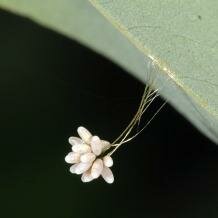 The outer shell of the egg sacs spun by garden spiders in the genus Argiope may be convergent on the paper-like silk secretions employed by vespid wasps in nest construction. A little more unusual than simple cocoons or coverings are the floating silken egg rafts made by some hydrophilid beetles (e.g. Hydrophilus piceus) and the silken egg stalks of green lacewings (Chrysopidae). Here, females secrete a drop of liquid silk from their colleterial glands onto the substrate, pull it into a thread and deposit an egg onto its tip. These silken egg stalks provide protection from predators and cannibalistic conspecifics. The stalk silk is well suited to this purpose, because it is considerably stiffer than silkworm silk.
The outer shell of the egg sacs spun by garden spiders in the genus Argiope may be convergent on the paper-like silk secretions employed by vespid wasps in nest construction. A little more unusual than simple cocoons or coverings are the floating silken egg rafts made by some hydrophilid beetles (e.g. Hydrophilus piceus) and the silken egg stalks of green lacewings (Chrysopidae). Here, females secrete a drop of liquid silk from their colleterial glands onto the substrate, pull it into a thread and deposit an egg onto its tip. These silken egg stalks provide protection from predators and cannibalistic conspecifics. The stalk silk is well suited to this purpose, because it is considerably stiffer than silkworm silk.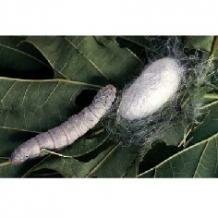
As common as using silk for an egg cover is the construction of protective pupation cocoons by larvae.  Best known are the cocoons of the silkworm (Bombyx mori), the major producer of commercial silk. These silk cocoons are secreted from paired labial glands and they also contain antimicrobial proteins that prevent bacterial growth on the immobile cocoon. All lepidopteran caterpillars make such cocoons, as do the larvae of many hymenopterans (e.g. the oriental hornet Vespa orientalis, where the cocoons seem to help with regulating temperature) and fleas (Siphonaptera). In other groups, the silk is not produced in the labial glands, but in the Malpighian tubules. Examples include the larvae of some beetles (e.g. weevils in the genus Hypera) and many neuropterans (e.g. the green lacewing Mallada signata).
Best known are the cocoons of the silkworm (Bombyx mori), the major producer of commercial silk. These silk cocoons are secreted from paired labial glands and they also contain antimicrobial proteins that prevent bacterial growth on the immobile cocoon. All lepidopteran caterpillars make such cocoons, as do the larvae of many hymenopterans (e.g. the oriental hornet Vespa orientalis, where the cocoons seem to help with regulating temperature) and fleas (Siphonaptera). In other groups, the silk is not produced in the labial glands, but in the Malpighian tubules. Examples include the larvae of some beetles (e.g. weevils in the genus Hypera) and many neuropterans (e.g. the green lacewing Mallada signata).
Other functions
There are even more extraordinary uses of silk. One is found in the social spider mite Stigmaeopsis longus, which constructs communal silk nests. Communal living requires strict hygiene, especially since these nests are narrow and humid. It is well documented that these mites deposit faeces in a ‘toilet area’ near the nest entrance. This is remarkable enough, but it has now been shown that females use silk threads as an ‘adhesive cleaner’. When the nest space was dirtied with artificial dust, female silk-weaving behaviour increased. Not only the nest itself seems to be cleaned in this way but also the egg surfaces (the eggs might be held in place by a web mat deposited underneath them).
 Another intriguing way of using silk is exemplified by the diving bell spider (Argyroneta aquatica), the only spider that spends its entire life underwater – despite lacking gills and having to breathe air. It lives in a dome-shaped web constructed between plants, which not only serves a protective function, but also holds a bubble of air that the spider carries down from the water surface. As the oxygen in this ‘diving bell’ is consumed, more oxygen diffuses in from the surrounding water. Hence, the bell can act as a physical gill and supply more oxygen than it originally contained, fully satisfying the oxygen requirements of at least a resting spider. Larger bells provide more oxygen, and spiders have been shown to adjust bell size according to their metabolic demands, so minimising risky trips to the water surface.
Another intriguing way of using silk is exemplified by the diving bell spider (Argyroneta aquatica), the only spider that spends its entire life underwater – despite lacking gills and having to breathe air. It lives in a dome-shaped web constructed between plants, which not only serves a protective function, but also holds a bubble of air that the spider carries down from the water surface. As the oxygen in this ‘diving bell’ is consumed, more oxygen diffuses in from the surrounding water. Hence, the bell can act as a physical gill and supply more oxygen than it originally contained, fully satisfying the oxygen requirements of at least a resting spider. Larger bells provide more oxygen, and spiders have been shown to adjust bell size according to their metabolic demands, so minimising risky trips to the water surface.
Perhaps the most unusual employment of silk occurs in the pseudoscorpion Cordylochernes scorpioides. To disperse this species rides on harlequin beetles (Acrocinus longimanus). Males may remain on a given beetle for at least two weeks to intercept and mate with dispersing females. But how do these males manage to stay attached while the beetle is flying? They weave a silken ‘safety harness’, strapping themselves securely to their host. Not only that – when exploring a potential new habitat, the pseudoscorpion can remain attached to the beetle with a silken thread, potentially allowing it to ‘re-board’ in case the location proves unsuitable.
Cite this web page
Map of Life - "Biological uses of silk: from webs to ballooning"
https://mapoflife.org/topics/topic_264_biological-uses-of-silk-from-webs-to-ballooning/
November 25, 2020

